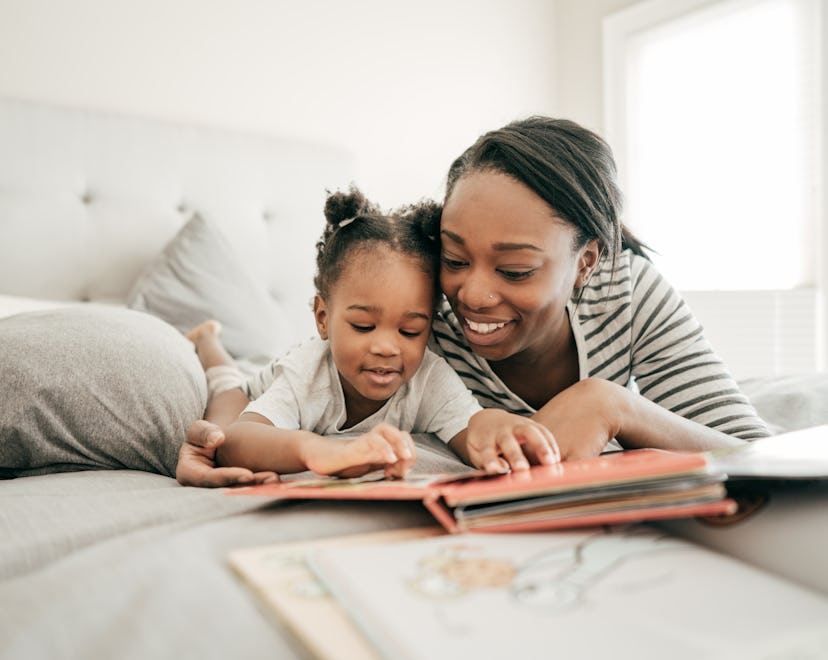Parenting

What Sight Words Are & Why They Matter
Help your kid get a leg up on learning to read.
A helpful building block for helping your child learn to read is teaching them to recognize sight words. If you started reading to your belly when you were pregnant or read to your child frequently when they were toddlers, they may have already developed a love for literature. Knowing exactly what sight words are and how to use them can increase their reading fluency by giving them the ability to quickly recognize certain high-frequency words as they begin their reading journey in elementary school.
Elementary teachers often incorporate sight words in the classroom — typically, kids get their first sight words list in kindergarten. But exactly what are sight words, and what is the theory behind this approach to teaching kids how to read?
What are sight words?
“Sight words are words we teach kids to learn by sight instead of sounding them out. It’s because the rules of decoding we’re teaching them don’t apply to sight words,” says Dara Jefferson, a reading interventionist and assistant principal in Jacksonville, Florida.
Decoding — or sounding words out — is one way that kids learn to read that involves breaking a word down based on the sound of each letter. But, it’s imperfect because there are so many words in the English language that are frequently used but don’t sound the way they look. Take, for example, the word ‘of.’ If your child were to try to sound it out, the letters ‘u’ and ‘v’ would be a more accurate way to match the sound of the actual word. Learning sight words — words children memorize and learn to recognize instantly by sight — is believed to accelerate the process of learning to read and counteract some of the confusion that sometimes comes along with trying to read by only sounding words out.
“The connotation of the word ‘sight word’ has morphed into a whole separate area of reading. Children are provided with ‘sight word lists’ and told to memorize words that are non-decodable,” says Kerry Savino, a reading specialist at Springfield Public Schools in Massachusetts.
Basic sight words
Sight words that your child may be expected to know will differ in complexity based on the grade your child is in. You should focus on whatever list of sight words your child’s teacher gives you, but here are a few examples of early elementary school sight words you can expect to see on those lists, share by Jefferson:
- Examples of Kindergarten sight words - all, do, be, now, four, saw, too, was, went, what, they
- Examples of 1st-grade sight words - then, after, again, every, about, fly, once, some, think, know, were, yes
- Examples of 2nd-grade sight words - people, after, could, before, because, around, found, made, right, their, upon, which
“Some sight words do overlap between grades, but older kids tend to have longer words they’re required to learn,” Jefferson says.
What is the Dolch word list?
Edward William Dolch was a Professor at the University of Illinois in the early 20th century, and is generally considered to be the creator of the concept of sight words. Dolch first expressed his belief in the importance of teaching children to read by having them memorize a basic sight word list in the late 1930s and then again in his 1948 book, Problems In Reading. “The Dolch word list is a list of 220 of the most commonly occurring words, excluding nouns, in children’s literature,” Marshall says.
While the Dolch list is the original, the Fry sight word list — created in the 1950s by Dr. Edward Fry and updated in the 1980s — is another commonly used resource in this method of teaching. The Fry list is focused on slightly older children and is made up of words that you’ll see the most in the English language. “Fry words are listed by frequency in groups of 100. The first 100 are the ones used most frequently,” Jefferson explains.
Both the Dolch and the Fry sight word lists are used in schools with the same goal — helping children learn words by sight to increase their reading proficiency.
You can support your child’s learning experience by using sight words to make reading fun and easy for them to grasp.
Sources interviewed:
Dara Jefferson, M.Ed., reading interventionist and elementary school assistant principal
Kerry Savino, M.Ed., reading specialist
Lauren Marshall, M.Ed., 5th grade Language Arts teacher
This article was originally published on